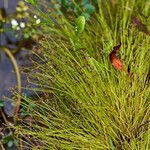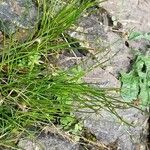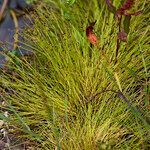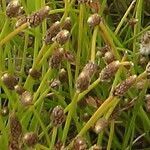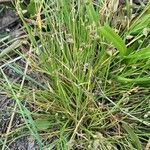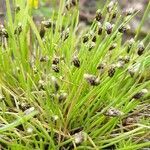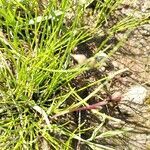Rhizomes creeping. Culms 3-12 cm tall, ca. 5 mm thick, terete, grooved. Leaves sometimes with only a sheath; leaf blade linear, usually shorter than culm, 0.2-0.5 mm wide, sometimes very short and deltoid or absent. Involucral bract 1(or 2), ovate-lanceolate, 3-10(-12) mm, spreading to erect, both surfaces dark red at base, apex long awned or mucronate. Inflorescence a pseudolateral head with 1-3 spikelets. Spikelets ovoid, 2.5-4 mm, many flowered. Glumes ovate to subelliptic, ca. 1.5 mm, both surfaces dark purple to purple, midvein greenish to straw-colored, apex rounded to obtuse. Perianth bristles absent. Stamens 2; filaments short, thick, with brown minute spots; anthers oblong, 0.3-0.5 mm; connective apex evident beyond anthers. Style short; stigmas (2 or)3, slender. Nutlet pale brown to orangish brown, broadly obovoid to subspherical, ca. 0.5 mm, plano-convex to compressed 3-sided, each surface prominently longitudinally ribbed, with many fine transverse ridges. Fl. and fr. Jun-Aug. 2n = 28.
Annual herb, tufted, 0.02-0.91 m high. Leaf blades capillary to filiform, 0.1-0.7 mm wide. Culm filiform, 0.2-0.8 mm in diam. Inflorescence a terminal head of 1-4 spikelets. Subtending bract erect to suberect, filiform. Spikelets ovate, 1.7-6.5 x 0.5-2.5 mm, 4-35-flowered. Glumes boat-shaped, 1.0-2.5 x 0.4-1.0 mm, keel ± non-excurrent. Style branches 3. Flowering time Aug.-Apr. Nutlet broadly elliptical, 0.7-1.3 x 0.4-0.9 mm, 3-angled, dark brown, surface trabeculate.
Tufted, annual herb, up to 150 mm high. Stems filiform. Leaves present, blades > 5 mm long. Flowers: inflorescence a terminal head of 1-few spikelets, basal bract erect to suberect, filiform; spikelets ovoid, 2.0(-3.5) x 1.5-2 mm; glumes pale, often with red markings or entirely red; style branches 3; Oct., Nov. Fruit a longitudinally ribbed nutlet.
Tufted annual, up to 150 mm tall. Stems filiform. Inflorescence a terminal head of 1-few spikelets, basal bract erect to suberect, filiform. Spikelets ovoid, 2(-3.5) x 1.5-2 mm, glumes pale, often with red markings or entirely red. Nutlets longitudinally ribbed.
Annual herb, up to 150 mm tall. Leaves present. Inflorescence composed of 1-3 spikelets. Spikelets ± 2 mm long. Style branches 3. Nut brown, longitudinally ribbed. Glumes obovate, obtuse, green-keeled, straw-coloured or light brown.
